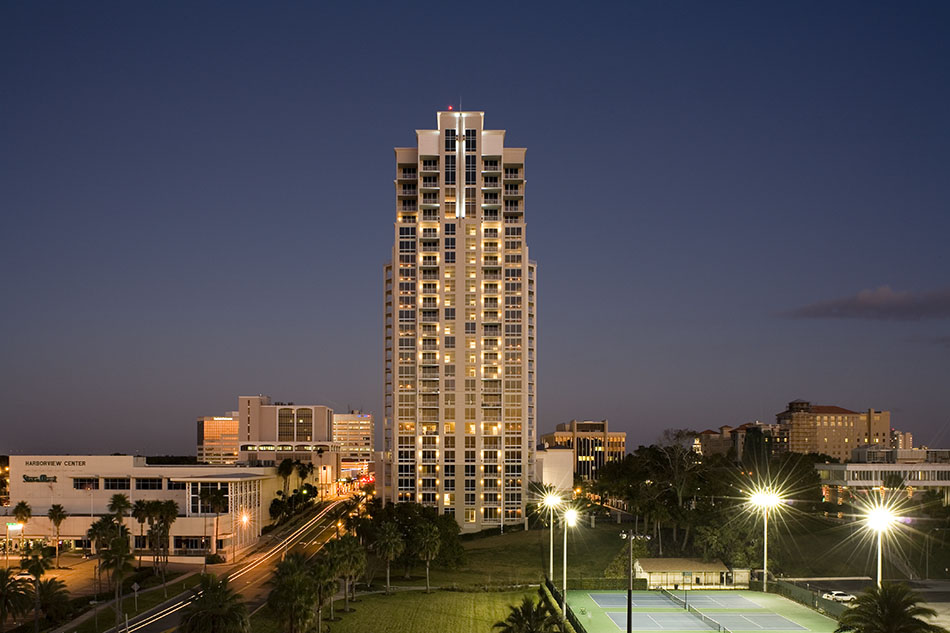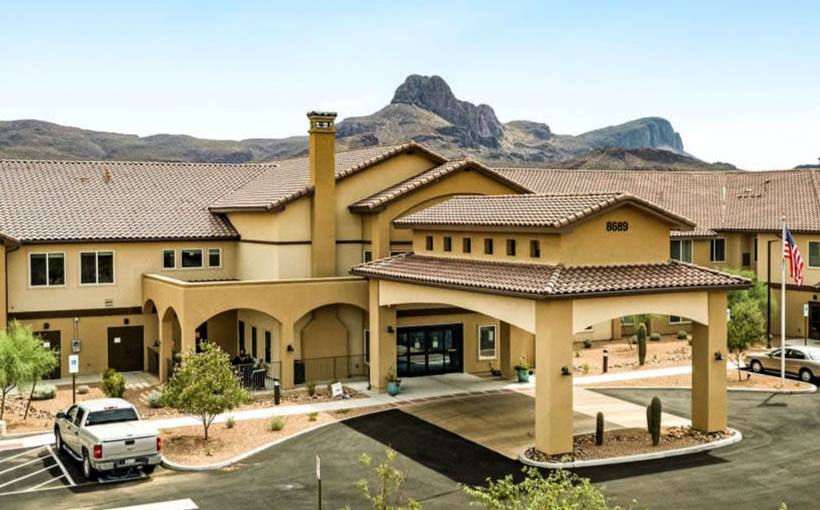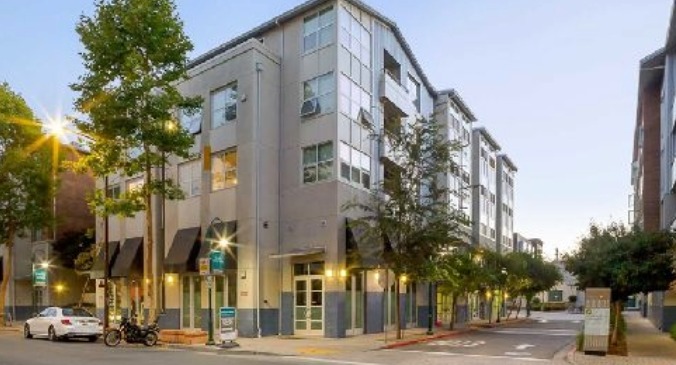
“Clearwater ghost comes back to life,” a local business journal declared above a story about Concierge Asset Management’s purchase at the beginning of July of a long-dark condo tower in the economically troubled city on the Gulf Coast of Florida. And, the Tampa Bay area’s Bay 9 TV featured Drever, Concierge’s founder and chairman, in the evening news after the classy grand re-opening of the 153-unit Water’s Edge drew nearly four times more attendees than anyone had expected at the end of July.
“I was pleasantly surprised when I heard we were getting a lot of RSVPs,” said Drever of the re-introduction to the market of the distressed condo asset that attracted nearly 750 attendees.
“Most local people told us we would be lucky if 150 showed up,” said the four-decade veteran of the multifamily business who made a 300 percent return, along with nine of his friends, on his first apartment investment in a Sausalito, Calif., triplex in 1967, kicking off a career that has earned him a reputation for an almost uncanny feel for when to get in and out of the acquisitions game.
The event that kicked off the sales of condo units in the tallest building in downtown Clearwater, which has stood nearly empty since developer Opus South finished it in 2008, generated enough sales in August to pay off the initial $14.2 million mortgage Concierge obtained to buy the property, Drever said recently.
Opus South spent more than $100 million to build the 26-story condo tower, where the developer sold 10 units for $6.8 million or $679,600 per unit, including a $1.5 million penthouse, before filing for bankruptcy in the spring of 2009. Wachovia Bank and its affiliated lenders acquired the asset for $20 million in a foreclosure auction last fall.
Drever credited Grant Wood, managing member of Stingray Asset Management LLC, Concierge’s on-the-ground ally and asset manager in Florida, and Wood’s marketing team, including United Landmark Associates, with master-minding the successful event that led to the continuing buying flurry at Water’s Edge. “He brought in an exclusive yacht broker and also had the local Bentley dealer ferrying people from our building down to the yachts,” said the veteran of value-add, who is applying his signature contrarian strategy to his second acquisition this year.
“Some people are telling us our pricing is too low,” said Wood, but that pricing strategy is proving successful. “It’s helping to not only stimulate getting people in the building, but is a major catalyst to jump-start the revival of downtown Clearwater and that’s his second bottom-line focus,” he said of Drever’s technique.
“The objective is to keep it low to keep the momentum going,” said Drever of the prices that are around half what Opus was charging, ranging from $194,900 for a 1,331 sq. ft. two-bedroom unit on which the original price tag was $422,000, to $1,016,900 for a 2,500 sq. ft. penthouse for which the original asking price was $1,748,500. “The competition is older buildings with higher prices and ours is state-of-the-art with drop-dead views, because we’re perched on a bluff right on the water, and there’s nothing like it in town,” he said.
Thanks to the appealing prices in an atmosphere of increasing consumer confidence, the sales office Stingray manages has seen more than 300 prospective buyer tours a month since the grand re-opening. And Wood attributes some of that success to the failed project’s former high profile as a symbol of economic collapse in the middle of downtown Clearwater, where other high-quality, but ill-timed, multifamily assets also delivered just before the credit market froze over.
“There was already a buzz in the community, especially with the local brokers. So, we reached out to all the local brokerage groups and a lot of the community leaders. The city has been tremendous in helping to get the property repositioned and create that excitement level,” said Wood, who developed partnerships with some complimentary businesses like Robb & Stucky, the local high-end furnishing retailer that dressed up the community’s model units.
“We’ve partnered with them and have been able to cross-promote, as we did with other relationships. We worked with Neiman Marcus and we’re working with Galati Yachts, a luxury yacht broker and the largest on the west coast of Florida,” he said. Through those partnerships and others like them, Wood was able to focus the targeted outreach on the purchaser demographic that would most likely have an interest in Water’s Edge, which includes a number of second-home buyers, he said.
Wood also is establishing financing opportunities for condo buyers. “We’re working right now with a couple of community banks, one in particular that is willing to do some end-loan financing for us,” he said, explaining that local banks love the second-home buyer seeking a banking relationship in Florida. “The banks get the benefit of an introduction and we get the benefit of being able to provide our purchaser with some end-loan financing options,” said Wood, who had deals in the works with a dozen or so qualified local purchasers and a couple of dozen out-of-town potential buyers in early September.
By the end of the first week in September, 32 units were under contract and the sales gallery was seeing 40 to 50 people coming through on a weekly basis, attracted by not only the great prices, but also the security of knowing that the new owner of Water’s Edge has created an escrow fund to cover the homeowners association dues for unsold units, protecting condo owners from large assessments down the road. Concierge also has funded reserves going forward, which the prior developer had waived, and seeded the reserve pool with $200,000, further reducing buyer risk.
And even the folks who paid twice as much as their neighbors-to-be are happy about the re-birth of their condos’ community. “I’ve met with just about all of them so far and they’re all realizing that the prices have come down from when they purchased two or three years ago, but, at the end of the day, they’d rather be in a stabilized property and they understand that long-term values are going to return and they’re going to be much better off by getting people in the building,” he said of the 10 original condo owners at the community Drever hopes will be lit up like a Christmas tree by the holidays.
A better business center environment, additional security levels for the elevator systems and a lot of fresh landscaping that creates a richer ambience and lifestyle are among the few improvements the nearly-new community needed. “We’re just kind of finessing things at this point,” said Wood, who is looking for similar distressed condo communities for Concierge to acquire in Florida, which is not the only market Drever is looking in now that his company’s acquisitions slow-down of the past several years has given way to a shopping expedition—his trademark pattern since the beginning of his career.
“Concierge and its predecessor companies have purchased and renovated more than 35,000 units over the course of the last four decades. In addition, in 1997 we merged the company and its 18,000-unit portfolio with Walden Residential properties, a NYSE-traded REIT,” Concierge Asset Management President and CEO Ted Kerr said recently, recalling the history of the company for which he was director of asset management between 1992 and 1997, when the company was known as Drever Partners, and director of operations for Walden after the merger.
“In 2000, Walden was sold and taken private and Maxwell restarted Concierge,” Kerr said. “Since that time, Concierge has purchased almost 8,500 units in total, on a selective basis, some of which have been sold. Today, Concierge manages almost 6,000 units and that total is on track to exceed 7,500 units by year-end, as Concierge and its partners close properties currently under contract,” said Kerr, who rejoined the company in 2007 and heads up its corporate office in Houston. “With our partner, we also have three Class A- and B garden apartment properties, totaling more than 1,300 units under contract in Dallas, Austin and San Antonio, which are scheduled to close in the coming weeks,” he said.
After buying no assets at all in 2009, Concierge and partner Crossbeam Capital bought the two-year-old, 17-story, 221-unit 415 Premier Apartments in the Chicago suburb of Evanston last April, with plans for a $2.2 million upgrade for the community that consists of 13 stories of apartments over four levels of parking. “Our renovation and enhancement program is nearing completion and occupancy has risen from 62 percent when we took over the property to almost 95 percent today,” Kerr said.
“We’re making offers from Seattle to Southern California to Georgia and even to Tennessee,” said Drever, adding, “We’re in a careful buy mode. In the last cycle, we were buying three a month and in this cycle, it’s more difficult to buy, but we expect to buy a fair amount of broken condominiums and, we’re hopeful, also broken apartment projects.”
Historically, his company has acquired a disproportionally large amount of properties in the fourth quarter of every year, often as other buyers have failed to close and sellers wanted assets off their books by year-end. While he is not so sure there will be many opportunities this year-end, if there are, Concierge will be ready, he said.
Known for his ability to sense sea changes in markets early, Drever decided in 2004 it was time to keep his powder dry and dramatically slowed down acquisitions, choosing to spend the intervening six years mostly selling units that had lived their useful lives as Concierge properties, while preserving what he calls his “patient investor capital,” which today includes $45 million of a partner’s dry powder.
Instead of focusing on acquisitions, he spent much of the past few years creating a top-tier property management company, while internally strengthening the construction company that handles the value-adding transformations of the troubled assets that Drever always has sought. “We’ve been biding our time,” said Drever, whose imaginative, unconventional style of adding value to properties that others might see as hopeless has proven so successful it merits a name of its own.
Tim Considine, AIMCO’s CEO, years ago christened the strategy “Dreverizing” and that game plan continues with the properties Drever’s buying today. It’s more than adding new plants or fancy fitness centers. Dreverization also involves revitalizing the communities in which the properties his company brings back to life are located. Clearwater, where Drever’s agent Wood has become involved with the city leaders and private groups dedicated to reviving the city’s economy, is an example of that community focus.
Clearwater’s mayor, Frank Hibbard, who spoke at the grand re-opening of Water’s Edge, voiced the community’s enthusiasm for Concierge’s effort on behalf of both the condos and the city, when he asked what Apple, Microsoft and Water’s Edge all have in common and answered, “They are all opportunities that you would have wanted in on, on the ground floor.”
Nor is such praise from community leaders uncommon for Drever, who has received letters from the mayors of large cities like Houston and Atlanta, congratulating and thanking him for reviving neighborhoods that were dying by acquiring and rehabbing communities other investors would shun, like a gang- and crime-infested apartment community in Alpharetta, where occupancy dropped to around 40 percent when Drever bought it in 2006 and evicted the problem tenants and deadbeats. He gave two apartments, rent-free, to police officers, who maintained a high profile in the community, and hired a patrol service to walk through it at night. Those image-changing efforts, along with major upgrades to the formerly shabby, neglected asset, increased the occupancy to 91 percent, while encouraging its neighbors to do the same.
“We’re glad to take the lead and then for others to follow. That’s how we’ve been able to restore whole neighborhoods. You can’t do it single-handed. It takes decades of experience and you learn from your mistakes,” said the veteran investor. “And now we make fewer mistakes and other people see that they’re not going to be making any mistakes by just following what we’ve done,” Drever said.
Author Peggy Shaw
















